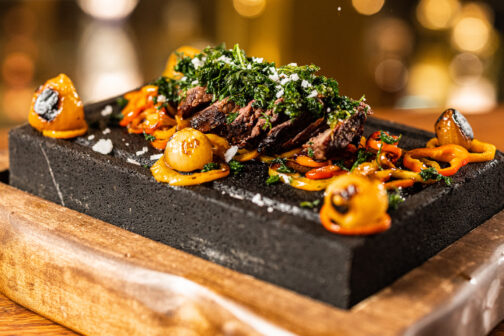Why do we go to restaurants?
Before I dove into food writing as a full-time job 14 months ago, I thought the answer was obvious: to eat yummy food. But there are many more reasons to dine out, and your reasons say a lot about who you are.
We’ll always need places to celebrate. But sometimes we also want to be spoiled, to escape from everyday life (and chores). Some of us want to bump into our friends, or take loads of selfies, or soak in the atmosphere and the people-watching. Restaurants can stand out for their location, their service, or the number of likes you get on Instagram the next morning.
You know all of this already. But I spent the spring thinking about these questions more deeply, and with greater historical context, while reporting this month’s feature on the future of the French Room. Dallas’ most historic, most opulent dining room is at a crossroads: the traits that make it so special (its architecture, grandiosity, and Frenchness) are falling out of restaurant fashion. Customers today have different visions for fine dining and special occasions. How can downtown Dallas’ culinary pride adapt to the times?
While investigating that question, I learned a great deal about the reasons people dine. The biggest takeaway for me involves today’s complaints about restaurants being too showy, too over-the-top, or designed for display. Think of the elaborate, theatrical meals you can have at Carbone, Komodo, or Monarch, where you feel like you’re onstage as part of the show—and paying for the privilege.
Well, guess what: that mode of dining is almost as old as restaurants themselves. I unearthed examples in both history books and old copies of D Magazine. Dallas restaurants were setting drinks on fire before the people who invented Instagram were born. And a century before that, restaurants in New York had fountains and live operetta orchestras. One century-old operator even called his own business “the cathedral of froth.” You can see for yourself in a lot of old movies. In comparison, a spot like Carbone seems kind of tame.
Another myth is that people today care less about food than they did before. In hindsight, the Bourdain era of mainstream foodie adventurousness might be a blip. One historian complains that in the 1960s, American travel guides were infected with “steak, lobster, and roast beef syndrome”; immediately after that era, our upper classes became infatuated with snooty “continental” restaurants that Calvin Trillin lampooned as “La Maison de la Casa House.” Then we transitioned into the era that nearly killed cocktails as decent drinking options. The grass may always seem greener in the past, but it wasn’t.
It’s funny to revisit old D Magazine articles and see the shifting reasons why we love to dine out. There’s no better illustration than a January 1982 review published about, yes, the French Room. Now, the French Room seems glamorous, stately, a great place to celebrate an occasion with your family. But in 1982, D’s writer was, uh—shall we just say it? D’s writer was aroused.
Behold: what might be the horniest restaurant review in Dallas history. You’ve been warned.
Newcomer: the French Room. Nothing short of something physical and amorous could surpass the sublime quality of this food. The decor is operatic in its erotic opulence, almost to the point of being overplayed. But you will most assuredly find yourself seduced by the luxuriousness of it all. This is an enlightened way to spend an evening (and some money). Inside the French Room, you are visually and acoustically cushioned from the outside world. So secure is that feeling and so subservient is the service (most of the waiters have come over from the Mansion) that you’ll feel as though you’ve been recognized as royalty just for having the good judgment to dine here. You should strive for personal satisfaction by ordering your “fantasy” food, something you’ve been craving for months. One salient piece of advice: Order the specials recited by your waiter whenever they appeal to you, particularly when the dishes involve seafood. While we found the menu selections consistently delightful, the specials were superior. From the menu, we’ve tried the Pithiviers d’Escargots (tender slivers of escargot with garlic and parsley inside an igloo-like pastry) and the Lobster Sausage with Sea Urchins, which was light and lobstery, but not nearly as exciting as the special seafood melange with langoustinos and the sweetest, most savory scallops we’ve ever eaten. The bisque of scallops with saffron had a delicate consistency and a pretty color, and was served just hot enough to force the taking of tiny tastes. (Adolphus Hotel, 1412 Main. Reservations accepted from 6 pm-10:30 pm. All credit cards. $$$$)
D Magazine, January 1982
If that whets your appetite, read our light and lobstery new feature on the French Room’s future in a new century.
Author







